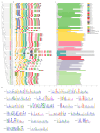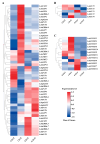Identification and Expression Analysis of Putative Sugar Transporter Gene Family during Bulb Formation in Lilies
- PMID: 38542476
- PMCID: PMC10970775
- DOI: 10.3390/ijms25063483
Identification and Expression Analysis of Putative Sugar Transporter Gene Family during Bulb Formation in Lilies
Abstract
Sugar transporters play important roles in plant growth and development, flowering and fruiting, as well as responses to adverse abiotic and biotic environmental conditions. Lilies (Lilium spp.) are some of the most representative ornamental bulbous flowers. Sugar metabolism is critical for bulb formation in lilies; therefore, clarifying the amount and expression pattern of sugar transporters is essential for further analyzing their roles in bulb formation. In this study, based on the transcriptome data of the Lilium Oriental hybrid 'Sorbonne' and Lilium × formolongi, a total of 69 and 41 sugar transporters were identified in 'Sorbonne' and Lilium × formolongi, respectively, by performing bioinformatics analysis. Through phylogenetic analysis, monosaccharide transporters (MSTs) can be divided into seven subfamilies, sucrose transporters (SUTs) can be divided into three subgroups, and sugars will eventually be exported transporters (SWEETs) can be divided into four clades. According to an analysis of conserved motifs, 20, 14, and 12 conserved motifs were predicted in MSTs, SUTs, and SWEETs, respectively. A conserved domain analysis showed that MSTs and SUTs contained a single domain, whereas most of the SWEETs harbored two MtN3/saliva domains, also known as a PQ-loop repeat. The LohINT1, which was predicted to have a smaller number of transmembrane structural domains, was cloned and analyzed for subcellular localization. It was found that the LohINT1 protein is mainly localized in the cell membrane. In addition, the expression analysis indicated that 22 LohMSTs, 1 LohSUTs, and 5 LohSWEETs were upregulated in 'Sorbonne' 1 day after scale detachment treatment, suggesting that they may regulate the initiation of the bulblet. A total of 10 LflMSTs, 1 LflSUTs, and 6 LflSWEETs were upregulated 4~6 months after sowing, which corresponds to the juvenile-to-adult transition phase of Lilium × formolongi, suggesting that they may also play a role in the accompanying bulb swelling process. Combined with quantitative real-time PCR (qRT-PCR) analysis, LohSTP8 and LohSTP12 were significantly overexpressed during the extremely early stage of bulblet initiation, and LflERD6.3 was significantly overexpressed during the growth of the underground bulblet, suggesting that they may be key sugar transporters in the formation of lily bulbs, which needs further functional verification.
Keywords: Lilium; bulblet development; bulblet initiation; expression analysis; sugar transporter.
Conflict of interest statement
The authors declare no conflicts of interest.
Figures











Similar articles
-
Transcriptome Analysis of Carbohydrate Metabolism Genes and Molecular Regulation of Sucrose Transport Gene LoSUT on the Flowering Process of Developing Oriental Hybrid Lily 'Sorbonne' Bulb.Int J Mol Sci. 2020 Apr 27;21(9):3092. doi: 10.3390/ijms21093092. Int J Mol Sci. 2020. PMID: 32349427 Free PMC article.
-
Full-Length Transcriptome Characterization and Functional Analysis of Pathogenesis-Related Proteins in Lilium Oriental Hybrid 'Sorbonne' Infected with Botrytis elliptica.Int J Mol Sci. 2022 Dec 27;24(1):425. doi: 10.3390/ijms24010425. Int J Mol Sci. 2022. PMID: 36613869 Free PMC article.
-
Expression Patterns of Sugar Transporter Genes in the Allocation of Assimilates and Abiotic Stress in Lily.Int J Mol Sci. 2022 Apr 13;23(8):4319. doi: 10.3390/ijms23084319. Int J Mol Sci. 2022. PMID: 35457135 Free PMC article.
-
SWEETs, transporters for intracellular and intercellular sugar translocation.Curr Opin Plant Biol. 2015 Jun;25:53-62. doi: 10.1016/j.pbi.2015.04.005. Epub 2015 May 15. Curr Opin Plant Biol. 2015. PMID: 25988582 Review.
-
Plant sugars: Homeostasis and transport under abiotic stress in plants.Physiol Plant. 2021 Apr;171(4):739-755. doi: 10.1111/ppl.13283. Epub 2020 Dec 1. Physiol Plant. 2021. PMID: 33215734 Review.
Cited by
-
Genome-wide identification and expression profiling of MST, SUT and SWEET transporters in Dendrobium catenatum.BMC Genomics. 2024 Dec 18;25(1):1213. doi: 10.1186/s12864-024-11121-4. BMC Genomics. 2024. PMID: 39695392 Free PMC article.
-
Genome-wide association study (GWAS) provides insights into the genomic basis of reproduction-related traits in Chouardia litardierei (Asparagaceae).BMC Plant Biol. 2025 May 2;25(1):577. doi: 10.1186/s12870-025-06617-4. BMC Plant Biol. 2025. PMID: 40316938 Free PMC article.
References
-
- Lemoine R., La Camera S., Atanassova R., Dedaldechamp F., Allario T., Pourtau N., Bonnemain J.L., Laloi M., Coutos-Thevenot P., Maurousset L., et al. Source-to-sink transport of sugar and regulation by environmental factors. Front. Plant Sci. 2013;4:272. doi: 10.3389/fpls.2013.00272. - DOI - PMC - PubMed
MeSH terms
Substances
Grants and funding
- 32372743/National Natural Science Foundation of China
- 32002071/National Natural Science Foundation of China Youth Science Fund Program
- 21052103-Y/Zhejiang Sci-Tech University Research Program Start-up Funding
- 11141131282001/Zhejiang Province first-class discipline (civil engineering) construction project
- 20220919Y1/2022 Hangzhou Agricultural and Social Development Scientific Research Guidance Project
LinkOut - more resources
Full Text Sources
Miscellaneous

